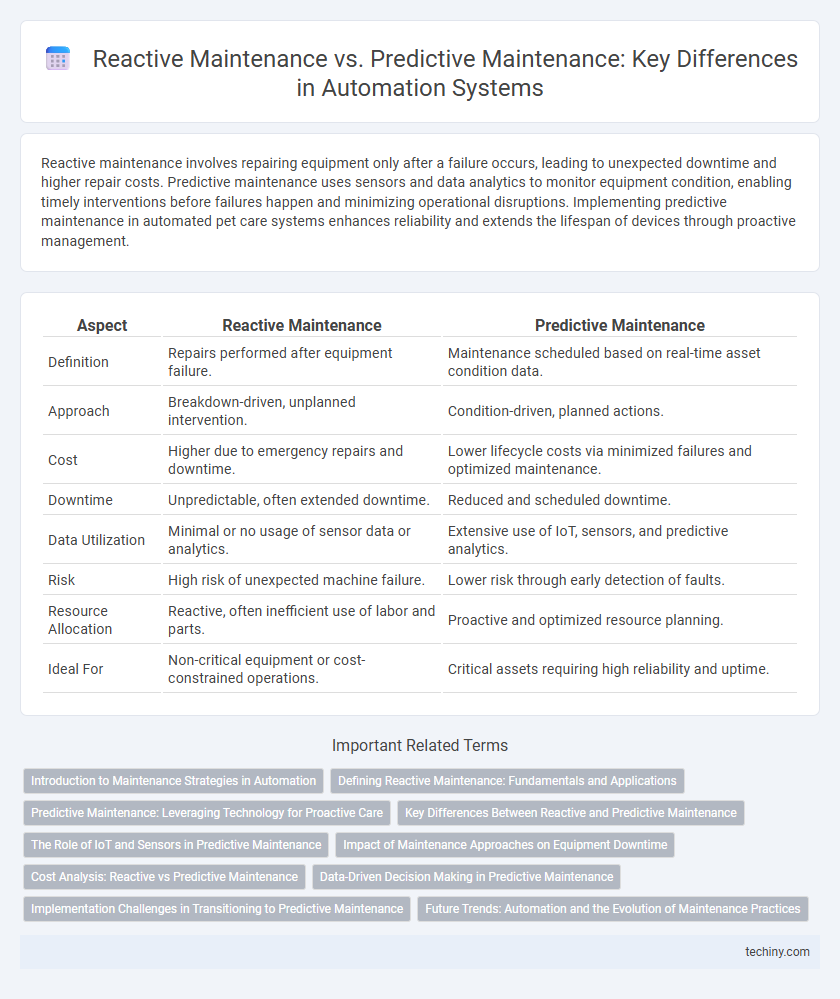Reactive maintenance involves repairing equipment only after a failure occurs, leading to unexpected downtime and higher repair costs. Predictive maintenance uses sensors and data analytics to monitor equipment condition, enabling timely interventions before failures happen and minimizing operational disruptions. Implementing predictive maintenance in automated pet care systems enhances reliability and extends the lifespan of devices through proactive management.
Table of Comparison
| Aspect | Reactive Maintenance | Predictive Maintenance |
|---|---|---|
| Definition | Repairs performed after equipment failure. | Maintenance scheduled based on real-time asset condition data. |
| Approach | Breakdown-driven, unplanned intervention. | Condition-driven, planned actions. |
| Cost | Higher due to emergency repairs and downtime. | Lower lifecycle costs via minimized failures and optimized maintenance. |
| Downtime | Unpredictable, often extended downtime. | Reduced and scheduled downtime. |
| Data Utilization | Minimal or no usage of sensor data or analytics. | Extensive use of IoT, sensors, and predictive analytics. |
| Risk | High risk of unexpected machine failure. | Lower risk through early detection of faults. |
| Resource Allocation | Reactive, often inefficient use of labor and parts. | Proactive and optimized resource planning. |
| Ideal For | Non-critical equipment or cost-constrained operations. | Critical assets requiring high reliability and uptime. |
Introduction to Maintenance Strategies in Automation
Reactive maintenance involves addressing equipment failures after they occur, leading to unplanned downtime and higher repair costs. Predictive maintenance uses real-time data analysis and sensor technologies to anticipate failures before they happen, optimizing asset performance and minimizing disruptions. Implementing predictive maintenance in automation enhances operational efficiency and extends equipment lifespan through condition-based monitoring.
Defining Reactive Maintenance: Fundamentals and Applications
Reactive maintenance involves repairing equipment only after a failure occurs, minimizing upfront costs but risking unplanned downtime and higher repair expenses. It primarily relies on short-term fixes without anticipating future issues, making it suitable for non-critical systems with low failure consequences. Common applications include backup generators, simple HVAC units, and non-essential machinery where operational interruptions have minimal impact.
Predictive Maintenance: Leveraging Technology for Proactive Care
Predictive maintenance harnesses IoT sensors, machine learning algorithms, and real-time data analytics to anticipate equipment failures before they occur, minimizing downtime and repair costs. This proactive approach extends asset lifespan by continuously monitoring performance indicators such as vibration, temperature, and acoustic emissions to detect anomalies early. Integrating predictive maintenance in industrial automation enhances operational efficiency, reduces unplanned outages, and improves resource allocation through precise maintenance scheduling.
Key Differences Between Reactive and Predictive Maintenance
Reactive maintenance responds to equipment failures after they occur, leading to unplanned downtime and higher repair costs. Predictive maintenance utilizes real-time data and condition monitoring tools such as vibration analysis and IoT sensors to forecast equipment failures before they happen. This proactive approach minimizes downtime, improves asset lifespan, and optimizes maintenance scheduling based on actual equipment health rather than fixed intervals.
The Role of IoT and Sensors in Predictive Maintenance
IoT devices and sensors play a crucial role in predictive maintenance by continuously monitoring equipment conditions and collecting real-time data on parameters like temperature, vibration, and pressure. This data enables advanced analytics and machine learning models to predict potential failures before they occur, reducing unplanned downtime and maintenance costs. Reactive maintenance, in contrast, relies on addressing issues after equipment failure, lacking the proactive insights provided through IoT-enabled predictive systems.
Impact of Maintenance Approaches on Equipment Downtime
Reactive maintenance leads to longer equipment downtime due to unexpected failures and emergency repairs disrupting production schedules. Predictive maintenance uses real-time data and condition monitoring, significantly reducing unplanned downtime by addressing issues before they cause failures. This approach improves operational efficiency and extends equipment lifespan through timely interventions.
Cost Analysis: Reactive vs Predictive Maintenance
Reactive maintenance often incurs higher costs due to unexpected equipment failures, emergency repairs, and unplanned downtime, which disrupt production and increase labor expenses. Predictive maintenance reduces overall expenses by leveraging real-time data and condition monitoring to schedule timely interventions, minimizing unnecessary parts replacement and extending asset lifespan. Companies implementing predictive maintenance strategies can achieve significant cost savings, with some studies reporting up to 30% reduction in maintenance expenses compared to reactive approaches.
Data-Driven Decision Making in Predictive Maintenance
Predictive maintenance leverages real-time sensor data and historical performance metrics to anticipate equipment failures before they occur, reducing downtime and maintenance costs. Data-driven decision making in predictive maintenance uses advanced analytics and machine learning algorithms to identify patterns and predict anomalies, enabling timely and precise interventions. This approach contrasts with reactive maintenance, which only addresses issues post-failure, often resulting in higher operational disruptions and repair expenses.
Implementation Challenges in Transitioning to Predictive Maintenance
Transitioning to predictive maintenance presents significant implementation challenges, including the integration of advanced IoT sensors and data analytics platforms into existing systems. Organizations often face difficulties in data quality management and the need for skilled personnel to interpret complex predictive algorithms. High initial costs and resistance to change among maintenance teams further complicate the shift from traditional reactive maintenance methods.
Future Trends: Automation and the Evolution of Maintenance Practices
Future trends in automation emphasize the shift from reactive maintenance, which addresses equipment failures after they occur, towards predictive maintenance that leverages real-time data analytics and machine learning algorithms to forecast and prevent breakdowns. Advanced IoT sensors and AI-driven condition monitoring systems enable more accurate predictions and efficient resource allocation, reducing downtime and operational costs. The evolution of maintenance practices integrates smart automation tools that facilitate continuous monitoring, data-driven decision-making, and proactive interventions in industrial environments.
Reactive Maintenance vs Predictive Maintenance Infographic

 techiny.com
techiny.com